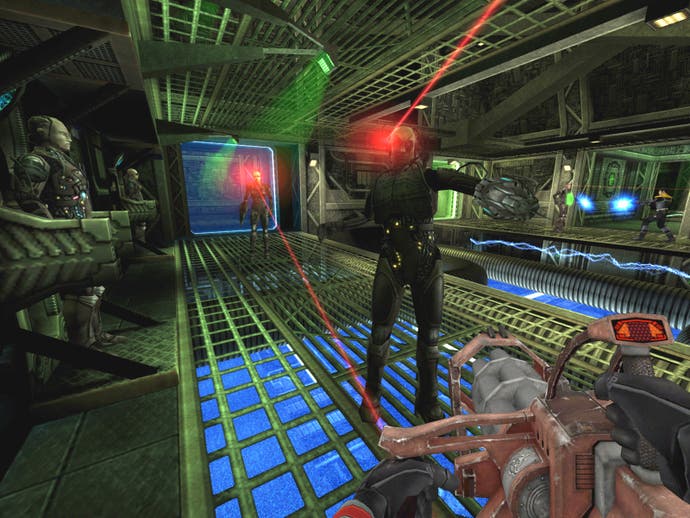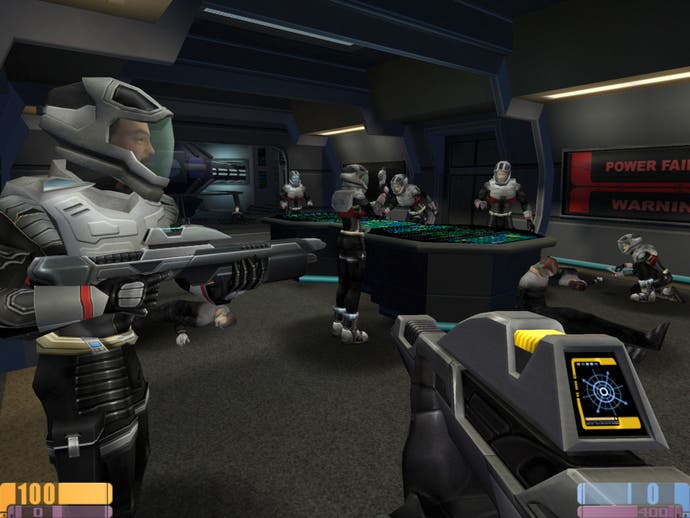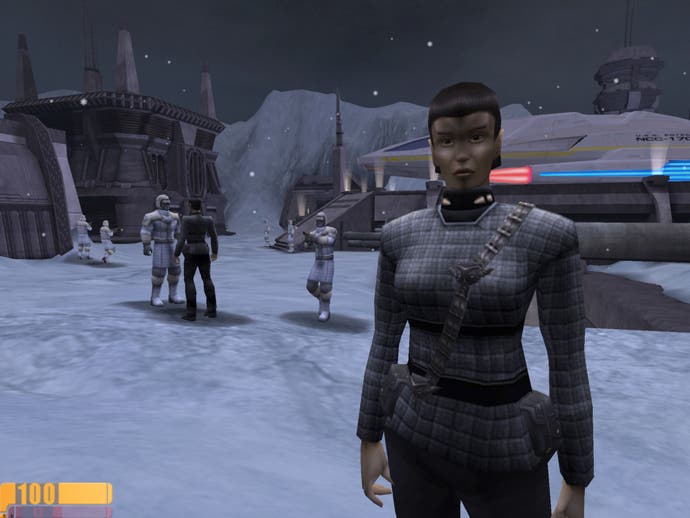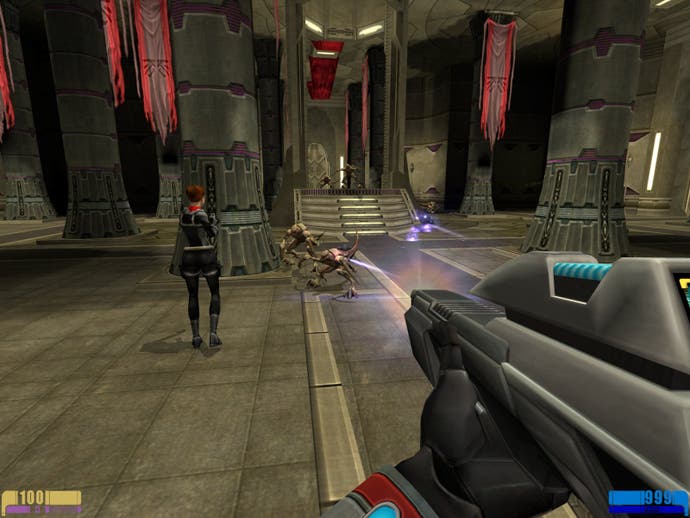Star Trek: Elite Force II
Worth beaming up?
Even die hard Trekkers, world renowned for their unbridled, costume-wearing, video-hording obsession with Gene Roddenberry's ubiquitous interstellar pageantry, must surely accept by now that Star Trek is at best somewhat inconsistent.
Enterprise, for example, arrived just in time to gobble up the final few intriguing sci-fi scenarios, managing to entertain us in fits and starts, but for every implausibly thoughtful script and uncharacteristically raunchy Jolene Blalock-based decontamination scene, there were far too many 'stuck on a moon with mind altering atmosphere' interludes, most of which we switched off in disgust.
In this sense then, Star Trek has a lot in common with first person shooters - particularly those thrown up by companies from that incestuous pocket of FPS development, Dallas, many of which rely on the same staple elements to pay the rent year after year.
Forced

Anybody who played Raven's rather enjoyable Elite Force will be instantly at home with Ritual's sequel, as the game uses many of the same characters and scenarios to make ends meet. You control the archetypal Federation scoundrel Alex Munroe, the gravely voiced head of the Voyager's elite Hazard Team, a unit created to dispense with the handbook and kill aliens indiscriminately in pursuit of reaching home.
This time the story takes its lead from the TV series, starting off with Voyager trapped inside a Borg sphere on its way to Earth via the green assimilators' trans-warp hub. As the ship and its crew are held up by a dampening field, the Hazard Team is dispatched to destroy whichever conduits/generators/emitters are responsible and free them up for the climactic scene of Endgame (the final episode of Voyager), and so once again we find ourselves wandering around trying not to piss off the collective.
With a rumbling sense of déjà vu, we start scouring the walls and knee-high ducts of the Borg fortress for destructible plasma whatsits to disable nearby force fields, occasionally stopping to jack some ammunition and health from the Half-Life inspired dispensers, fighting our plodding enemies whenever they decide we pose a real threat. And it isn't too surprising when things suddenly go wrong, our feeble team-mates suddenly become objectives to secure, and our amazing guns that the Borg can't adapt to are suddenly immobilised.
Voyaged

A few hours later though, and we're still plodding away at Elite Force II, and it it's almost certainly down to the story. OK, it's nothing spectacular - the Hazard Team is disbanded and then reformed on Enterprise, a couple of alien races are in a spot of bother, big Exomorph enemies need dispatching and so on - but it's handled rather like a Star Trek mini-series, with lots of our favourite characters from Next Generation, familiar locations and plenty of incidental detail, like bickering students at Starfleet Academy and crewmen on the Enterprise blurting out specious theories about the ship's plight as they stroll past you in the corridor.
Intertwined with the usual tale of galactic ethics and 'diplomacy' is the ongoing relationship between Munroe and fellow Hazard Team member Telsia. They've had a bit of a thing for a while, but this time you'll be tasked with keeping their relationship going via occasional dialogue menus, which branch their story off down different tangents. And Munroe, very much the Captain Kirk figure on away missions, often finds himself fending off the attractions of alien doctors and other lonely hearts.
Much like Raven's, Ritual's is a loving recreation of the Star Trek universe, from the vast Academy courtyards in San Francisco and the grimy Romulan-popping Holodeck sequences to those new worlds and new civilisations we keep hearing about, and it does a good job of backing up the story. What's more, their two new alien races - the seductive Idryll and bulbous Attrexians - fit snappily into place, and even inspire some of the game's best action sequences, like defending an Attrexian ship and searching their rainy facility for survivors and Exomorphs.
Enterprising

Visually at least, the Quake III engine - in one of its final outings - lends itself superbly, keeping the system requirements to a relative low, whilst maintaining high levels of detail. We actually ran the game in 1280x1024 with everything switched on, without paying the price in dropped frames. Of course the game still has the distinctive look and feel of Carmack's former technology, but Star Trek episodes - certainly the bits of it we're dealing with here - were always renowned for their smoothly contoured architecture and vid screen content, and tight-fitting unblemished uniforms. Beyond that, all the Q3 tech has difficulty with is human mannerisms and facial expressions.
Once you escape the confines of typical Star Trek ships and facilities, the game continues to look good, making old sci-fi clichés like ruins and space swamps look sufficiently rundown, unkempt and falling apart at the seams, and painting our new alien friends and enemies with the same brush strokes as the TV series' make-up artists and CG gurus.
That said, the architecture of mission levels draws perhaps too heavily on the previous game and other Dallas-based FPSs. Apart from the opening section - which might just as well have been from Elite Force - we felt the influence of Quake II in a lot of the greying alien architecture.
Beamed there, done that

Indeed, at times it feels like the familiarity of the venerable technology has rubbed off on the rest of the game, much of which suffers at the hands of the 'been there, done that' brigade. Weapons, though on the whole pretty meaty and fitting for Star Trek, aren't new or particularly improved, from the basic phaser, which is still weak and slow to recharge, to the various shotgun and laser weapons.
Likewise enemy placement and set-pieces are predictable, with walls blowing out in the middle of corridors to reveal big, blue-blob-slinging enemies, and your newfound Attrexian compatriots being heroically massacred as you watch helpless from behind a sheet of surprisingly tough glass shielding. As for having to kill all the enemies to open the next door... haven't we seen enough of that by now? And FPS platform sections too?
What is perhaps a bit more commendable is the way some of your enemies behave. In one early section, Munroe and a Klingon crewman are fighting their way through a sea of Romulans, who beam in for a sneak attack, and instead of just searing them with shock rifles our heroes are forced to dive in and out of cover exchanging fire, as the Romulans cower behind crates and scenery. It almost has the feeling of a saloon shootout, and the lean function certainly adds something - although we'd have preferred a Raven Shield style fluid movement approach.
Invert the polarities!

However despite a few moments of skill, these gunfights are seldom more than pedestrian, largely because your typical cannon fodder attacks with all the subtlety of Unreal 2's creepy crawlies, and the action is often broken up by tedious puzzles that have you searching for something to blow up or recalibrate. The implementation here is a bit different thanks to the mysterious bleepy Tricorder, which gives you cute little logic puzzles to overcome, matching sine waves and rotating power couplings, and lets you scan the nearby environment for destructible scenery, but on the whole the formula for progression remains unchanged. Played an FPS in the last five years? You'll do fine.
It's only when the Tricorder is forced into use in the midst of battle that Elite Force II threatens to break the mould, but even here it's use is somewhat contrived. Take the first 'boss battle' - if you like - with that Predator-looking Borg weirdo who well and truly towers over Munroe like an assimilated Cyberdemon. Instead of just ploughing energy blasts into his chest, the idea is to knock out some of his shield generation, and to do this Munroe has to use his Tricorder on three separate consoles in corners of the room. But, instead of throwing up a clever logic puzzle and forcing you to sweat the solution before stompy gets close enough to assimilate, all you have to do is hold the left mouse button like you're defusing the bomb or something.
Even later on, when you're in a sea of poison gas and your crewmate tells you to look for gas vents with your Tricorder, then seal them up with your phaser, you almost wish you'd had to figure it out by yourself. Instead, it feels a bit like you're being yelled at. "Deal with that vicious gas problem! Click here to find out more!"
Replicated

On balance, Elite Force II is a pretty respectable FPS, but like Unreal 2 it's the game's inability to innovate consistently that compels us to give up. Were it not for characters with personalities deeper than their cup-size, the realisation of the Star Trek world and Patrick Stewart bellowing at stupid bureaucrats, we might have given up before we got to the end.
Also like Unreal 2, once finished we're left with very little to do. There's a multiplayer mode, but it feels like an afterthought. Obviously it's difficult to judge whether it'll take off barely four days after the game's gone on sale, but our overriding impression of it is that, rather like the original Elite Force multiplayer, it's an amusing distraction to be hauled out at LAN parties and quickly forgotten by the internet. It certainly doesn't try to take on CS, UT2003 or BF1942 for multiplayer domination.
As for replay value in the single player game, which took us the best part of ten hours to complete, there are a few golden spaceships implausibly dotted around every level, like the ones Picard got in a hissy fit and broke during First Contact, but we couldn't be bothered to collect them all just to get at a few secret levels. By the time you're finished with Elite Force II, we doubt you'll feel like it either. This really is one for Star Trek fans and FPS lovers.

